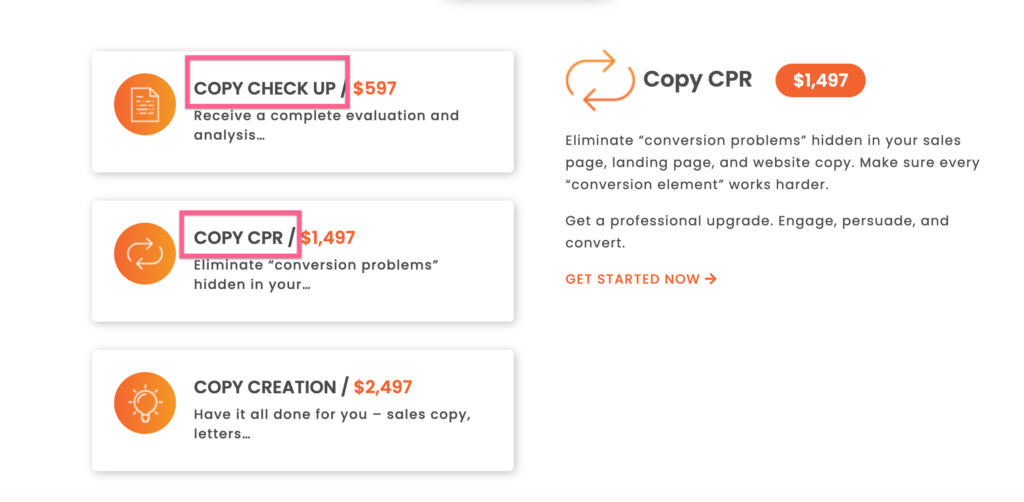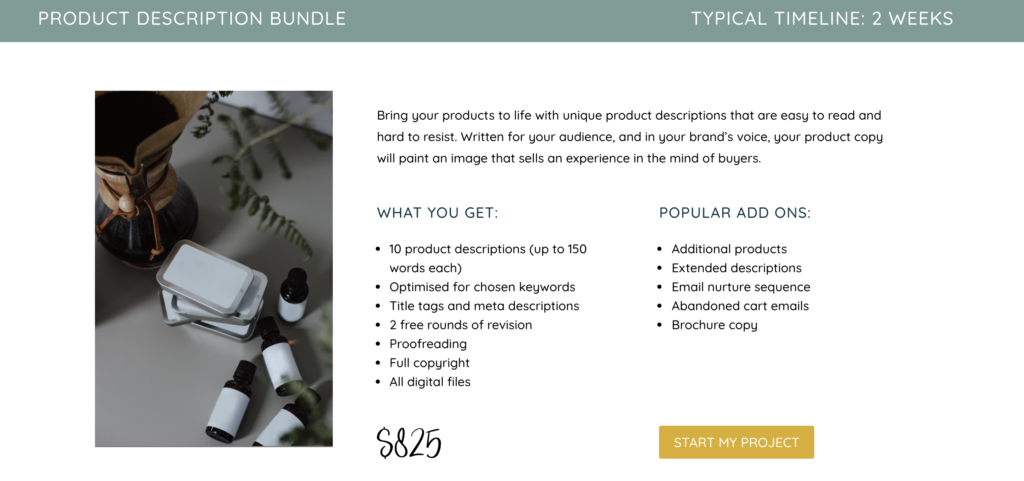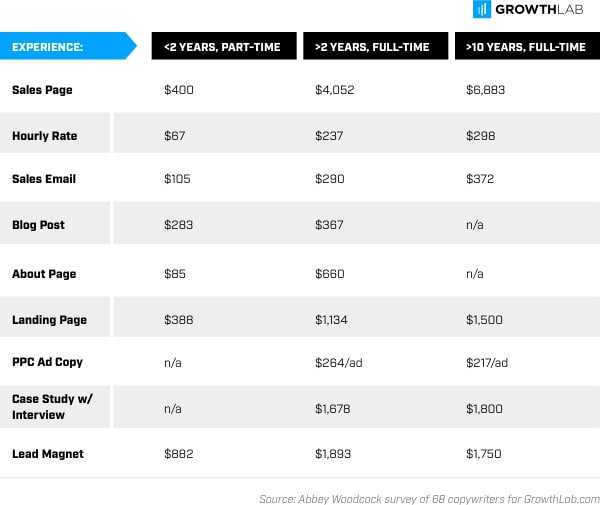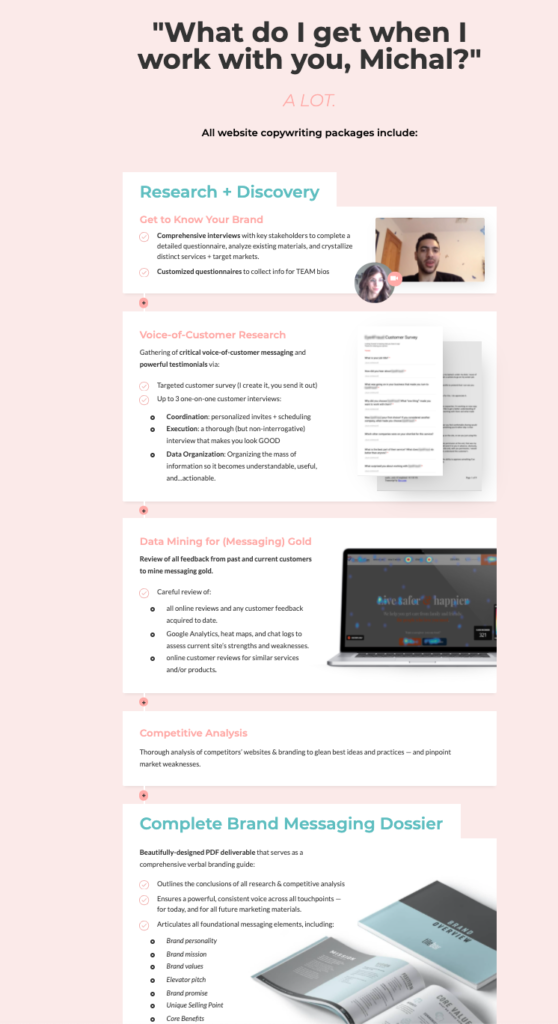A client comes to you. He asks you to write three ads, a landing page and the About page for his website.
Quick: What wouldya charge for that?
If the question has got you stumped, you’re not alone. Setting your rates as a freelance copywriter ain’t easy.
For starters, there are no market standards. There are people that charge $20 per hour and others that charge $200. Some freelancers accept 5 cents per word, while others charge $1 (please, if you’re the former, STOP RIGHT NOW! Undervaluing your services is not only detrimental to YOU but to all other freelancers who want to make a decent living).
So that begs the question: What the efff SHOULD you charge??!
To answer that, let’s take a look at the different pricing models to consider and the things that your rate will depend on.
Freelance copywriting pricing models
1. Hourly
Charging by the hour is common amongst freelancers just starting out.
Butttt try to avoid going this route if you can.
Here’s why: As you become more efficient (and finish projects faster), you’ll end up making LESS money.
It’s also not an accurate reflection of the value you’re providing.
For example, let’s say you charge $80/hour for a sales page that takes you six hours to complete. You make $480 in the end, but that sales page goes on to generate $100,000 in sales.
That $480 doesn’t do your work justice, does it?
Didn’t think so.
So when SHOULD you charge by the hour (if ever)? If you provide copy consulting services…or if the project isn’t clearly defined, then charging by the hour could be a good way to go. But if you do, then use this handy rate calculator to get an idea of what you should be charging.
You should charge at least double your former hourly wage to account for downtime, expenses, health insurance, taxes, admin work, sick days etc. As a general rule of thumb, you shouldn’t charge less than $50 per hour when starting out.
And don’t bill by the half-hour. Set project minimums. So if your client asks for just one hour of your time, then charge her for two (or three…or four). You’ll obvs need to state that upfront so the expectations are clear from the get-go.
2. Day rate
A day rate includes all the work you complete for a client in a single day (duh).
Day rates are common practice in Europe (or at least in the UK), and amongst high-earning freelancers in the U.S.

So just how much can you expect to make in a day? Many experienced freelancers charge upwards of $2,000 a day. But if you’re a newbie, start out at $500.
3. Flat fee
With a flat fee approach, your client pays you for the work you complete (the results). Not for the length or the time you spent on it.
So long as the project scope is defined, the expectations are clear from the get-go. There are no hidden surprises on either end. The downside is that if you end up spending WAY more than you think you will on a project, you’ll end up doing yourself a huge disservice (speaking from experience here!).
4. Packaged services
Wanna increase the perceived value of your services? Offer packaged services (aka related projects grouped together).
Sooo, you might offer your client a sales page, along with a series of emails and ad copy to promote that page. You could package everything together and give it your own unique, branded name, like “The Sales Powerhouse” (just made that up).
Check out what this fitness copywriter did:

Notice the on-brand names, as well. The only thing I’d recommend doing differently is listing out the deliverables and benefits included in the package, like copywriter, Kelly Eamens, does:

The way Kelly packages and presents her service makes it seem much higher value than just “10 product descriptions,” dontcha think?
Lastly, make sure that the package you’re offering your client is a good fit for their needs. Come up with your packaged service offerings and then, if you need to, customize those offerings to your client.
5. Tiered
Tiered pricing is all the rage with SaaS companies, but why not give it a go with your freelance business?
With this type of pricing model, you segment your services based on your clients’ needs and budget, offering three (or four) options of the same type of service:
- A low-priced service (includes only the basics)
- A moderately priced service (includes a range of services)
- A high-priced service (includes everything)
You can expect that most clients will go with the middle option, so make that one stand out.
Some advantages to this pricing model? It gives your prospective client choices (making it more likely that you’ll seal the deal).
It also helps to avoid scope creep, which is when you and your client agree to something and then they start to make additional requests that they didn’t pay for (the WORST).
6. Retainer
The problem with freelancing is that once you complete a project, there’s no guarantee when you’ll get another one.
Enter: The retainer (and no, I’m not talking about the thing you put in your mouth).
A retainer is a contractual agreement between you and your client for recurring work each month. For example, your client might pay you $2,000 for 20 hours of work.
A retainer is a win-win for both parties: Clients get to reserve you for your precious time AND they can work with someone who already knows their business (resulting in a faster turn-around time and higher quality work). And YOU have the reassurance of knowing that you can rely on a steady paycheck each month.
If your client comes back to you more than once or you sense that they have a need for recurring projects, suggest a retainer agreement. It’s pretty standard to offer a slight discount, as well.
To get them on board, tell your client how the retainer will save them time, money and result in higher quality work.
And again, DO NOT trade your hours for time here. Doing so makes it easier for your client to question how your hours are spent and back out of the arrangement.
Instead, offer them a fixed number of services. So, for $4,000 per month, you might offer:
- 2 hours of copy consulting
- 4 emails
- Copy for 10 ads
- Ongoing A/B testing of the website copy
- One monthly strategy and planning call
This way, your client doesn’t know how much each service is costing them and how many hours you’re spending. Instead, they’re getting clear deliverables that will help them grow their business.
Once you have your client on retainer, continually track results from your work. Then show those results to your client to remind them why they should hold onto you.
Trade hourly pricing for value-based pricing
When pricing your services, the key is to STOP trading your time for hours.
As Steve Slaunwhite, author of The Wealthy Freelancer, put it,
“A client may balk at paying you $100 an hour for 10 hours of work, but will have no objection to a project price of $1,000 for the same project. Why? It’s all in the way a client looks at it. If your hourly rate is more than her hourly salary, she may think you’re asking too much. A fixed-project price, however, takes that salary comparison out of the equation, making the client stop and consider if the project is worth the price instead of considering whether you are worth [it].”
Here’s an example: Freelance designer, Jake Jorgovan, once charged $60 per hour for a website he designed. The project ended up taking him three hours to complete, so the client paid $180 in the end for a high-quality website.
One month later, Jake designed another website. But this time, he charged the client based on the scope of the work, emphasizing the value of the project rather than the number of hours it would take him to complete.
He ended up billing the client $4,250, and the website only took him FIVE HOURS to create.
Freelance developer, Matt Olpinski, also started out charging hourly. He slowly increased his rate over time, until he reached $125/hour. At that point, he started facing resistance from clients. They couldn’t justify paying more than $150 per hour when they could find someone cheaper….
The truth is, not many clients are going to pay a $2,500/hour rate. But they would pay $10,000 price for a solution that can make their business $100k+ next year.
Like Jake and Matt, think about the value of the services you’re providing. According to Matt, “a true value-based price is typically 15-25% of the clients first year of realized revenue.”
What will determine your rates?
While it can help to see what other freelancers are charging, don’t base your rates off that. You don’t know why are they charging what they do or the quality of their services. Most freelancers charge far too little, anyway.
Don’t determine your rates based on your location either. At the end of the day, it doesn’t matter where you live so long as you can deliver high-quality work.
What DOES matter are the following:
Skill level
Forget years of experience. What’s your skill level?
If you’re good at what you do, it doesn’t matter whether you have 10 years of experience as a copywriter or six months. What’s important are the end results that you can bring your client.
If you’ve never written a piece of copy in your life or don’t have any portfolio to speak of, you’ll obviously have to prove yourself before you can charge premium rates.
The good thing is that you don’t have to get hired by anyone to start copywriting.
So you could….create a website on WordPress and show off your copywriting skills there! Convince potential clients why they should hire you.
Look at other websites and rewrite the copy. Write emails for your favorite brands.
You get the idea.
Industry
What industry are you targeting? Startups that are barely getting by or big-budget businesses? The answer to that will, in part, determine your rates.
Some higher-paying industries include health/medical care, finance and SaaS (software as a service).
But ultimately, you can find high-paying clients in almost any industry. To get an idea of a company’s budget, look at things like:
- number of employees (check out their About or LinkedIn page)
- website traffic (use a tool like Ubersuggest or SEMrush)
- number of social media followers (although take this with a grain of salt)
- any possible funding
Specialization
The more specialized you are, the easier it’ll be to market yourself. You’ll face less competition, and clients will be able to find you more easily. You’ll also be able to charge more for your services.
So how do you pick a niche? Well, friends, that’s a topic reserved for a whole other blog post.
But I will tell you this: You can niche horizontally or vertically.
With a horizonal niche, you focus on one type of copywriting (like sales pages, emails, ad copy etc) for all (or a range of) industries.
With a vertical niche, you focus on the industry or type of client (but do all types of copywriting). The main benefit of choosing a vertical niche is that you know the main paint points and challenges of the audience you’re targeting.
You could also niche vertically AND horizontally. Likeee landing pages for personal finance businesses. Or email marketing for the travel industry.
You could even niche down on the type of copy you write. Like Kira Hug, who writes “weird conversion copy”:

Still feeling lost?
Think about what your ideal client sells and if it’ll be worth it to them to spend big bucks on copywriting services. If they sell high-priced products or services, then there’s a good chance it will be.
Copywriter and entrepreneur, Dan Lok, decided to focus on selling events. As he puts it,
“…I knew I could make a lot of money with that as such events are usually high-ticket offers. I was able to charge a few thousand bucks. My client knew that if my copy would sell 3-4 seats at their event, then they already made back what I charged.”
Type of project
Take a look at the copywriting fee ranges from AWAI:

And here’s more data from Growthlab:

Some freelancers charge more and others charge less. But that at least gives you a ballpark of what you can start with.
Turnaround time
If your client asks for a faster turnaround time, then you should ask to be compensated more for that. So if the client requires a 24-hour turnaround time, you could charge 50% more.
Should you post your rates?
Some freelancers do and others don’t.
You could publish a range if you don’t want to lock yourself down to a set price. The advantage to doing this is that you won’t get cheapos contacting you and your prospects will know that you aren’t trying to pull a fast one on them.
As copywriter, Dean Rieck says,
Plus, a range with your normal writing rates at the lower end allows you to say to your clients, “I usually charge from $500 to $2,000 for this type of work. For you, I’ll stay near the bottom of my scale. Say $700.” Clients like that. It helps to close sales.
Last words of advice
Just remember: YOU’RE the boss here. YOU decide how much to charge.
And if something doesn’t work, then learn from it and change things for the next client that comes knockin’.
Track your time (for YOURSELF)
We all have a natural tendency to underestimate the time it takes us to complete something (helloooo planning fallacy).
For that reason, EVEN IF you don’t charge by the hour, you should track your time. Why? It can give you an idea of whether or not your rates are accurate and help you set realistic deadlines.
I highly recommend Timeular. It’s this cool little dice that assigns a task to each side…

Total game-changer. I’ve tried other apps before, but this thing makes me WAY more diligent about tracking my time.
Stop trading your time for money
Emphasize the deliverables and benefits of the services you’re providing, NOT the number of hours that go into them.
Mention everything that your dear clients are getting as soon as they sign that contract, like copywriter, Michal Eisikowitz, does:


Don’t give discounts
Whatever rates you set, be confident in them. And don’t feel let down if someone turns your services down because they’re “too expensive”. ‘Cause guess what? If everyone can afford you, you aren’t charging enough.
Whatever you do, do NOT be that copywriter that negotiates with clients. ‘Cause then the client will lose respect for you, and you’ll set a baaaaad precedent for future projects.
If your client really IS on a tight budget, then you could reduce the scope of the project.
Bottom line: Don’t undersell yourself. If you’re new to copywriting, you’ll have to start out somewhat “cheap.” But as you build experience and get testimonials under your belt, you should increase your rates.
Ok, so *now* are you feeling confident with what to charge? You got this.


